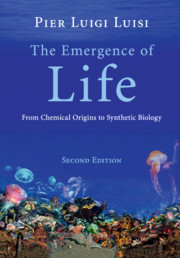Book contents
- Frontmatter
- Contents
- Acknowledgments
- Introduction
- Part I Approaches to the origin of life
- 1 Setting the stage
- 2 The hardware
- 3 Ascending the ramp of complexity
- 4 Experimental approaches to the origin of life
- 5 Origin of life from ground zero
- Part II What is life? The bio-logics of cellular life
- Part III Order and organization in biological systems
- Part IV The world of vesicles
- Part V Towards the synthetic biology of minimal cells
- As a way of conclusion
- Appendix The open questions about the origin of life
- References
- Names index
- Subject index
3 - Ascending the ramp of complexity
from Part I - Approaches to the origin of life
Published online by Cambridge University Press: 05 September 2016
- Frontmatter
- Contents
- Acknowledgments
- Introduction
- Part I Approaches to the origin of life
- 1 Setting the stage
- 2 The hardware
- 3 Ascending the ramp of complexity
- 4 Experimental approaches to the origin of life
- 5 Origin of life from ground zero
- Part II What is life? The bio-logics of cellular life
- Part III Order and organization in biological systems
- Part IV The world of vesicles
- Part V Towards the synthetic biology of minimal cells
- As a way of conclusion
- Appendix The open questions about the origin of life
- References
- Names index
- Subject index
Summary
Introduction
Looking again at our “famous” Figure 1.2, we may realize how bold Oparin was to assume that there should be a spontaneous increase of molecular complexity from the simple molecules up to the first cells. Bold because this process should take place in a prebiotic scenario deprived of the “intelligence” of enzymes and of the “memory” of nucleic acids: only the basic natural laws were then in operation.
There are many processes in nature that permit an increase of complexity and are attended by a negative free energy change – namely they are under thermodynamic control – “spontaneous” reactions, just to use a simplified term. Think of the bubbles being formed in soap – spherical structures made up of billions of molecules, which spontaneously find their place in such a regular aggregate. Or, think of some spontaneous polymerizations – for example, styrene under the effect of sunlight, or the de-mixing of a water-oil emulsion. These are also examples of self-organization, processes which are thermodynamically favored and constructing at the same time higher order. We will devote an entire chapter to self-organization in Part IV of this book, where we will be discussing the self-organization of surfactant molecules, which produce aggregates such as micelles or vesicles, bilayers, and liposomes.
The increase of size given by self-organization would not be enough to proceed towards life. We need an increase of functionality as well, namely the arising of novel properties. And this is indeed what we will discuss: when smaller parts are brought together – be it surfactant molecules as in the bubble or in membranes, or protein moieties forming tissues – new properties arise (new in the sense that they are not present in the constituent parts). These are the “emergent properties,” a very important element to construct life. This is, in fact, the most important departing point from the vision of reductionism and we will deal in detail with this notion – together with self-organization – in Part II of this book.
Thus, going up Oparin's ladder along the pathway of molecular evolution is marked by a natural increase of molecular complexity and the arising of novel properties. This is a very general and vague statement that requires further discussion and examples, which will be done more extensively later on in the book.
- Type
- Chapter
- Information
- The Emergence of LifeFrom Chemical Origins to Synthetic Biology, pp. 57 - 71Publisher: Cambridge University PressPrint publication year: 2016



